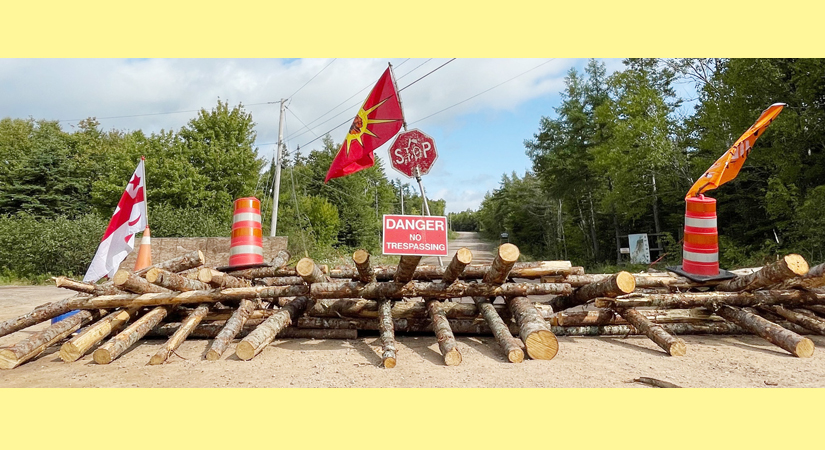The Mi’kmaw blockade is back up on Hunter’s Mountain after the RCMP took it down. Photo by Tynette Deveaux.
September 10, 2025
-by Beverley Phillips
The Mi’kmaw community has risen up in support of the forest on Hunter’s Mountain, protesting the clear-cutting of the land.
On September 4th, Mi’kmaq from around Cape Breton gathered and blocked logging trucks, even confiscating a load of felled trees. They remain on the mountain, and the protest continues to grow. Tynnette Deveaux, regional manager of Canadian Association of Physicians for the Environment, said that while organizer Ashton Bernard was taken into custody on Monday and everything was confiscated, he has been released and the blockade is back up.
In a statement leading up to the demonstration, organizer Ashton Bernard wrote on Facebook that “the Mi’kmaq people will gather at the Hunter’s Mountain entrance to stand in unity against the ongoing destruction of our lands, waters, and rights.”
He wrote about how others are profiting from their land, and while they have been caretakers of these mountains for ages, their voices are ignored, and they receive no financial compensation for the use of their land.
He further noted that clear-cutting destroys not just trees, but habitat, for both moose and salmon, as the forest protects the rivers and the estuaries from floods and erosion.
“Our medicines, plants, and sacred foods are disappearing, destroyed by non-Native loggers, while the province stands by and approves the destruction of Mi’kmaq resources and way of life.”
“These are treaty lands. And we are here to protect them – for our ancestors, for ourselves, and for the generations yet to come.”
In a statement, the Maw-lukutijik Saqmaq (Assembly of Nova Scotia Mi’kmaw Chiefs) said they supported the protest.
They continued:
“We are supposed to be co-managers of these lands, waters, and resources, yet decisions continue to be made that are impacting our position and our rights,” said Chief Tamara Young, co-lead of environment, energy, and mines for the assembly. “Our concerns are often overlooked and dismissed, and it is clear that community members are frustrated with the position that puts us in as a nation.”
“We are all frustrated that the co-management of these resources feels limited and isolated, rather than part of a more holistic conversation with the Mi’kmaq about the Highlands ecosystem and the impacts of forestry, herbicides, recreational use, and mining exploration. We are proud to see community members raising their voices on these important issues,” said Chief Carol Potter, co-lead of environment, energy, and mines for the assembly.
The Kwilmu’kw Maw-klusuaqn (Mi’kmaq Rights Initiative) critiques current forestry practices on its web page (mikmaqrights.com), stating those practices place “far too much emphasis on cutting and re-planting forest resources on an industrial scale, for immediate financial gain with insufficient priority given to forest, water, and wildlife health and sustainability.”
As a nation, the Kwilmu’kw Maw-klusuaqn say, the Mi’kmaq practice Netukulimk, which provides for the “basic community and individual needs as well as economic security, without jeopardizing the continued integrity, diversity, and productivity of the environment.”
The best way to manage the land is by “using both traditional Mi’kmaq knowledge and Western scientific understanding,” a concept known as “Two-eyed seeing.”
The protesters will continue to be on the mountain and want Premier Tim Houston to sit down with them to discuss how to go forward with joint management of the forest.






